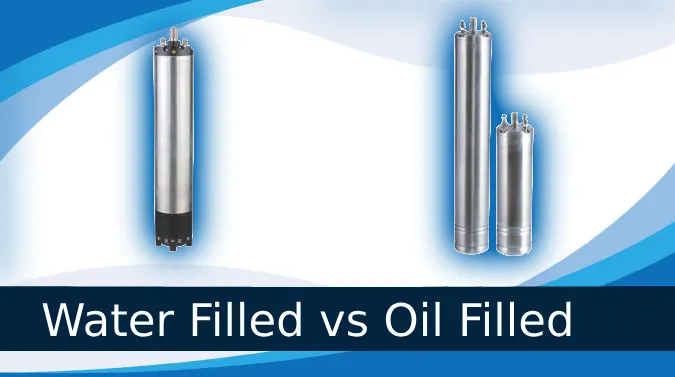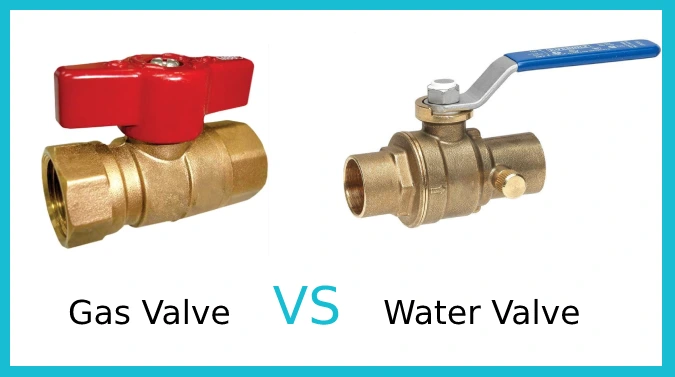Last Updated on July 16, 2023
Selecting the ideal submersible pump entails evaluating numerous considerations. Among the crucial aspects to contemplate is the choice of a water-filled or oil-filled submersible pump.
Water-filled submersible pumps use water as a coolant to dissipate heat generated by the motor. In contrast, oil-filled submersible pumps rely on oil-based cooling systems for optimal motor cooling.
Moreover, each pump’s type of electrical winding system can significantly impact its overall efficiency and performance. Also, factors such as faulty sealing, rusting, and maintenance can all influence the durability and longevity of the chosen pump’s service life.
Our in-depth analysis of water-filled and oil-filled submersible pumps leads you to the most suitable choice based on your specific needs.
The Differences Between Water Filled vs Oil Filled Submersible Pump

The difference between a water-filled and oil-filled submersible pump is important if you’re shopping for one. Depending on your well depth, water source quality, and pumping needs, each type of pump may have different applications and uses.
Here are the main differences between water-filled and oil-filled submersible pumps:
- Application and Use Cases
- Electrical Winding System
- Impact of Faulty Sealing
- Rusting
- Service Life and Maintenance
- Bearing Type
- Contamination and Corrosion
- Energy Efficiency
- Temperature Considerations
- Cost
01: Application and Use Cases
When selecting water-filled and oil-filled submersible pumps, you should consider particular applications and use cases. Here are some factors to keep in mind:
Water-filled pumps are ideal for smaller applications, such as groundwater pumping and water supply systems. They are also commonly used for clean water circulation or boosting. These pumps are designed to be energy-efficient and cost-effective, ideal for residential use.
On the other hand, oil-filled pumps are better suited for larger applications, such as water tower water delivery, flood prevention, and municipal drainage. These pumps are designed to handle heavy-duty tasks and can operate for extended periods without overheating.
Also, oil-filled pumps are more durable and can withstand harsh environments, making them a great choice for commercial and industrial use.
No 02: Electrical Winding System
In water-filled pumps, the winding system is within the motor and is directly in contact with the water. This can cause corrosion and damage to the winding system in case of a short circuit, leading to difficulty in repairing the pump.
The process of removing the motor from the water for repairs is also not easy and can be time-consuming.
Conversely, oil-filled pumps have their winding system encapsulated in oil, providing insulation and water protection. In a short circuit, the oil can be drained and the winding system can be inspected and repaired. Also, the motor can be easily removed from the oil without any water contamination.
No 03: Impact of Faulty Sealing
Faulty sealing in submersible pumps can lead to significant damage. Studies show that over 50% of the pump failures are due to seal-related issues. In oil-filled pumps, the consequences of faulty sealing can be particularly severe.
Oil leakage can cause damage to the ball bearings and other parts of the pump, leading to a decrease in efficiency and even complete pump failure. Also, the oil that leaks out can cause environmental damage and risk human health.
In contrast, water-cooled systems can reduce the risk of oil leakage and allow for more efficient operation.
No 04: Rusting
It’s frustrating to deal with rust in submersible pumps, especially when it can lead to costly repairs and maintenance. Rust is a major problem for water-filled submersible pumps, as they are more prone to corrosion when exposed to impurities or corrosive elements.
Contrary to this, oil-filled submersible pumps are not prone to rust, even after prolonged periods of non-use. The oil creates a barrier between the metal parts of the pump and the surrounding water, preventing rust from forming.
This makes oil-filled pumps more durable and reliable, especially in harsh environments or when pumping water with impurities.
No 05: Service Life and Maintenance
For prolonged performance and peak pump proficiency, proper and periodic pump maintenance must be practiced. This is especially true for water-filled submersible pumps requiring regular upkeep to ensure optimal performance and longevity.
Without proper maintenance, these pumps are prone to rust and corrosion, which can severely shorten their service life.
Due to better lubrication conditions provided by mechanical oil, oil-filled submersible pumps generally have a longer service life. These pumps have self-lubrication capabilities that contribute to their durability, reducing the need for frequent maintenance.
But, it’s still important to inspect and maintain the pump’s components periodically to ensure that it’s working at peak efficiency. This includes checking the oil level and quality and cleaning and inspecting the impeller and motor.
No 06: Bearing Type

You should consider using ball bearings in your submersible pump to ensure optimal efficiency and reduce friction. Ball bearings used in oil-filled pumps have a lower coefficient of friction and are better able to handle high loads than bush bearings used in water-filled pumps.
This is because ball bearings have rolling elements allowing smoother movement and less contact with the bearing surfaces. Also, ball bearings are able to maintain their performance even at high speeds. It makes them a great choice for submersible pumps that need to operate at faster speeds.
No 07: Contamination and Corrosion
In oil-filled pumps, a compromised seal can lead to oil contamination of the pumped water. It can be harmful to the environment and expensive to clean up. If the oil is not removed promptly, it can cause damage to the pump’s mechanical components.
On the other hand, water-filled pumps are less prone to corrosion caused by the pumped water, making them a more suitable choice for pumping clean water. The water surrounding the pump’s mechanical components acts as a natural barrier, protecting them from corrosion.
No 08: Energy Efficiency
Maximizing energy efficiency is crucial when selecting a submersible pump, as it can lead to significant cost savings and reduced environmental impact. Oil-filled submersible pumps are known for their higher energy efficiency than water-filled pumps.
The oil in these pumps has a higher specific heat capacity, which means it can store and transfer more heat energy with less temperature change. This translates to less energy required to pump the same amount of water, resulting in lower electricity bills.
Water-filled submersible pumps can adjust their speed with variable frequency drives (VFDs) based on the water demand. This can reduce energy wastage due to excess pumping and help maximize energy efficiency.
No 09: Temperature Considerations
Oil-filled pumps are recommended for colder climates because they perform well in extreme temperatures. The oil inside the pump acts as a lubricant, reducing friction and wear on the motor’s moving parts. This ensures the pump can start up smoothly and run efficiently, even in freezing temperatures.
Also, the oil acts as a heat sink, absorbing and dissipating heat generated by the motor, which can prolong the pump’s lifespan.
Then again, water-filled pumps are well suited for climates with dry conditions. In these regions, the temperature can be high, and the water inside the pump can help cool the motor, preventing it from overheating.
Water-filled pumps are also less likely to freeze in cold weather, making them a good choice for regions with mild winters.
No 10: Cost
It’s a shame that the price of oil-filled submersible pumps can deter people from investing in their superior performance and durability.
Due to the additional complexity and components involved in the construction of oil-filled pumps, they are generally more expensive than water-filled pumps.
Conversely, water-filled pumps are generally more affordable, so they may be a better option for those on a tight budget.
Can water-filled pumps operate quietly?
You’ll appreciate how quietly water-filled submersible pumps operate compared to other types. Here are three reasons why:
- The motor and impeller are completely submerged in the water, reducing the amount of noise generated by the pump.
- Water is an excellent sound absorber, so the surrounding water muffles any noise generated by the pump.
- A water-filled pump is designed to run smoothly and efficiently, reducing vibrations and noise even further.
Does an oil-filled submersible pump perform better than a water-filled one?

Opting for an oil-filled submersible pump can result in greater energy efficiency and lower overall costs than its water-filled counterpart. Oil-filled pumps are designed with better insulation and can withstand high temperatures, making them ideal for heavy-duty applications.
The oil also acts as a cooling agent, which helps to prevent the motor from overheating and reduces the risk of damage.
On the other hand, water-filled pumps may be less energy-efficient and more expensive to operate, but they are better suited to shallow water. They’re also generally quieter than oil-filled pumps, which makes them ideal for residential areas.
The choice between a water-filled or oil-filled submersible pump will ultimately depend on the particular needs of the user and the environment. Making a decision requires taking energy efficiency, noise level, and cost into consideration.
Water Filled or Oil Filled Submersible Pump: Make an Informed Decision
After weighing the advantages and disadvantages of water-filled and oil-filled submersible pumps, you can now make an informed choice when purchasing one that best suits your needs.
If the noise level is a major concern, then a water-filled submersible pump may be an ideal choice for you as they are known for its quiet operation. Also, water-filled pumps offer better heat dissipation than oil-filled pumps because of the constant cooling effect of the liquid inside the motor.
But, if you require a pump that can withstand extreme temperatures and harsh environments, an oil-filled submersible pump will be a better option. These pumps contain oil as a coolant and lubricant in the motor, providing superior resistance to overheating and harsh operating conditions.
So, it is important to highlight that choosing the right submersible pump for your specific application is crucial for its optimal performance and longevity.



